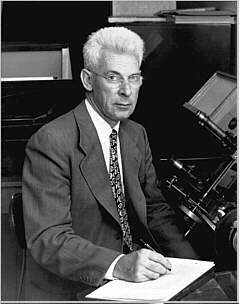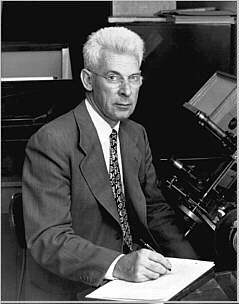Nicholson became interested in astronomy while studying at Drake University in Des Moines, Iowa, from which he graduated in 1912. Two years later, while observing Jupiter's moon Pasiphaëat with the Lick Observatory 36-inch Crossley reflector, he discovered a new Jovian satellite -- Sinope -- whose orbit he computed for his 1915 Ph.D. thesis. He spent the remainder of his career working from Mount Wilson Observatory, with occasional observations made with the 200-inch telescope at Palomar Observatory near San Diego, California. During his Wilson-Palomar years, he discovered an additional three Jovian moons: Carme and Lysithea in 1938, and Ananke in 1951. Historically this put Nicholson in very unique company, for he was now the sole discoverer of four Jovian moons, a feat equaled only by Galileo Galilei in the 1600s. His other notable discoveries include the main-belt asteroid 878 Mildred (namesake of the Mildred family of asteroids), and the Trojan asteroid, 1647 Menelaus.
His main assignment at Mount Wilson Observatory was solar activity. For many years he produced MWO's annual reports on sunspot activity, and he made numerous eclipse expeditions around the globe to measure the brightness and temperature of the solar corona. In the 1920s, Nicholson, along with Edison Pettit, made the first systematic infrared observations of celestial objects using a vacuum thermocouple. This led to the theory (later proven correct) that the Moon is covered with a thin, insulating layer of dust. Pettit and Nicholson's thermal radiation measurements of nearby giant stars also led to some of the first determinations of stellar diameters. Additionally, Nicholson, together with astronomer George Ellery Hale, lends his name to the "Hale-Nicholson law" concerning the magnetic polarity of sunspots.
Nicholson was a member of the Astronomical Society of the Pacific. He twice served as its president, and from 1943 to 1955 was editor of their journal "Publications of the Astronomical Society of the Pacific". Among his honors, awards and memorials are the Bruce Medal (1963), the asteroid "1831 Nicholson", the lunar crater "Nicholson", the Martian crater "Nicholson", and "Nicholson Regio" on Ganymede, a moon of Jupiter. The latter is an especially fitting tribute, considering his Jupiter System discoveries.
Nicholson became interested in astronomy while studying at Drake University in Des Moines, Iowa, from which he graduated in 1912. Two years later, while observing Jupiter's moon Pasiphaëat with the Lick Observatory 36-inch Crossley reflector, he discovered a new Jovian satellite -- Sinope -- whose orbit he computed for his 1915 Ph.D. thesis. He spent the remainder of his career working from Mount Wilson Observatory, with occasional observations made with the 200-inch telescope at Palomar Observatory near San Diego, California. During his Wilson-Palomar years, he discovered an additional three Jovian moons: Carme and Lysithea in 1938, and Ananke in 1951. Historically this put Nicholson in very unique company, for he was now the sole discoverer of four Jovian moons, a feat equaled only by Galileo Galilei in the 1600s. His other notable discoveries include the main-belt asteroid 878 Mildred (namesake of the Mildred family of asteroids), and the Trojan asteroid, 1647 Menelaus.
His main assignment at Mount Wilson Observatory was solar activity. For many years he produced MWO's annual reports on sunspot activity, and he made numerous eclipse expeditions around the globe to measure the brightness and temperature of the solar corona. In the 1920s, Nicholson, along with Edison Pettit, made the first systematic infrared observations of celestial objects using a vacuum thermocouple. This led to the theory (later proven correct) that the Moon is covered with a thin, insulating layer of dust. Pettit and Nicholson's thermal radiation measurements of nearby giant stars also led to some of the first determinations of stellar diameters. Additionally, Nicholson, together with astronomer George Ellery Hale, lends his name to the "Hale-Nicholson law" concerning the magnetic polarity of sunspots.
Nicholson was a member of the Astronomical Society of the Pacific. He twice served as its president, and from 1943 to 1955 was editor of their journal "Publications of the Astronomical Society of the Pacific". Among his honors, awards and memorials are the Bruce Medal (1963), the asteroid "1831 Nicholson", the lunar crater "Nicholson", the Martian crater "Nicholson", and "Nicholson Regio" on Ganymede, a moon of Jupiter. The latter is an especially fitting tribute, considering his Jupiter System discoveries.
Gravesite Details
Cemetery records say he is in the Guardian Vault. His son Don contacted me and said his father was cremated and scattered in a private place. Both accounts are shared here for historical accuracy.
Sponsored by Ancestry
Advertisement
Records on Ancestry
Advertisement







